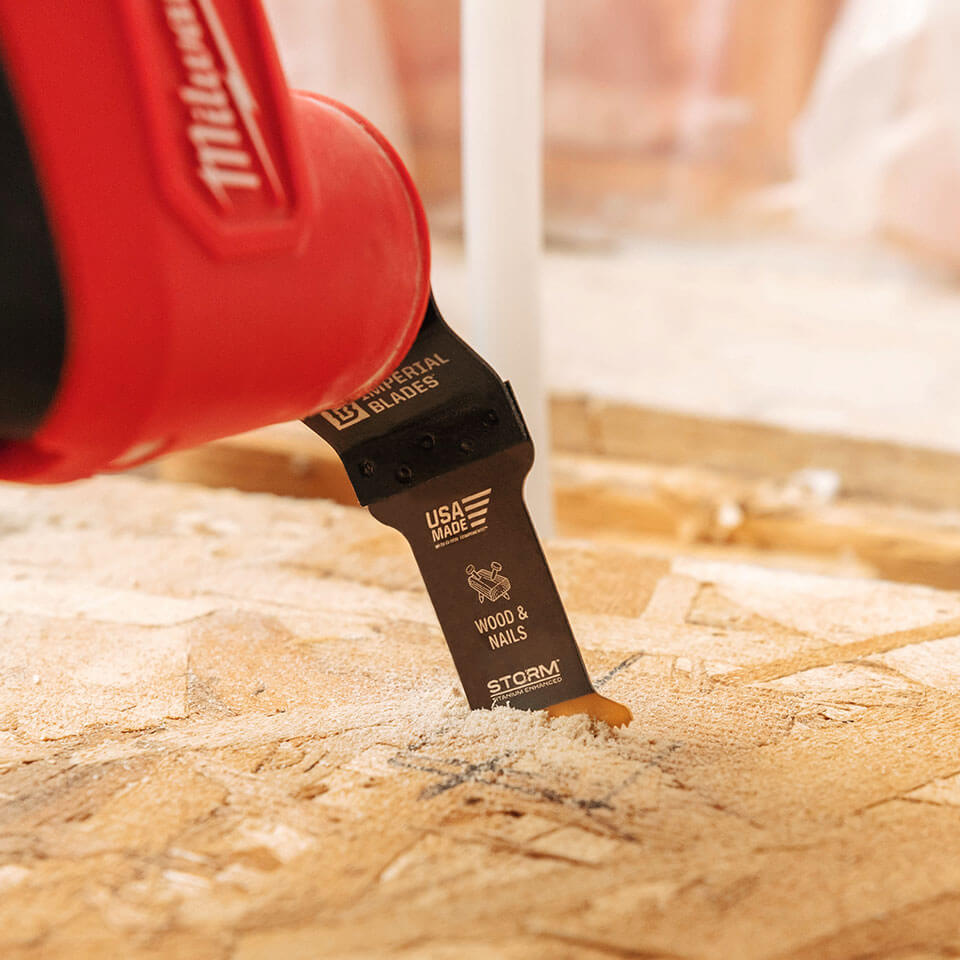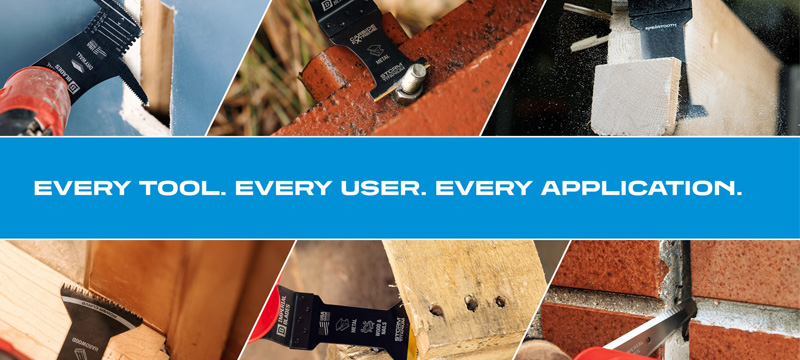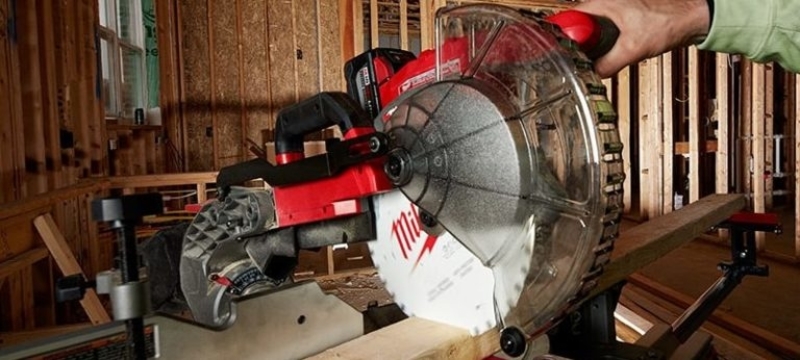Oscillating multi-tools and their wide variety of blades and accessories allow a wide range of users to tackle numerous projects. Whether you’re a professional in many trades or a DIYer, multi-tools are a must. The compact size and lightweight of an oscillating tool, aka oscillating multi-tool (OMT), allows the operator to work in places other equipment wouldn’t fit.
What roles do Oscillating Multi-tool blades perform?
OMT tools have three primary roles: cutting, scraping, and sanding. An oscillating tool performs these different tasks only by changing the blade or attachment. This allows the machine to perform an endless variety of functions. Because the OMT is an essential tool, it’s crucial to select the correct blade for the task at hand.
What makes an Oscillating Multi-tool Blade so effective?
It is crucial to understand how oscillating multi-tools work and what allows them to be effective on so many applications. OMT tools use a high-speed, side-to-side motion of a relatively small blade compared to most cutting power tools, which create a circular motion (circular saws) or a long front to back cutting motion (reciprocating saws). The OPM, or oscillations per minute, of up to 20,000 strokes per minute with only a 3- to 4-degree radius, allows for precise control with minimal vibration. The tool won’t create nearly as much dust with the blade’s side-to-side motion. This easily handled tool allows the operator to make cuts and do tasks not achievable with other power tools. Additionally, due to the stepped profile of most blades, it allows for flush cutting on all surfaces, especially in hard to reach areas.
What blade should I use?
Different kinds of materials require specific blades for the best results. For instance, a blade with longer and fewer teeth per inch will cut wood easily but will quickly dull if used to cut brass plumbing pipe or trim exposed nails. Inversely, a blade with more and shorter teeth, specially coated with titanium or laser welded with “bi-metal” (high-speed steel strip on a high carbon steel blade), allows for cutting metal.
Additionally, the multi-tool blade accessory category also offers carbide tooth blades for the toughest metal and abrasive applications. These include hardened bolts, deck screws, rebar, plaster, brick, cement board, and more. Blades and attachments come in many different shapes, sizes, and configurations. Although some blades will cut many materials and do different jobs, take time to select the best blade for the task. Blade selection is not always about “what can it cut” but should be more about “what should it cut.”
Common Uses for an Oscillating Multi-Tool and the Recommended Blade:
| Task | What to look for in a blade | Suggested Blade |
| Caulk Removal: | Go with a scraper blade. Some scraper blades are flexible and ideal for scraping light material. An excellent choice is a rectangular-shaped blade with opposing precision-ground cutting edges. |  |
| Concrete Crack Chasing: | This is a tough job, so go with a carbide-grit grout removal disk or blade. |  |
| Brick & Concrete: | To cut concrete, brick, plaster, grout, or other porous materials, check out a diamond or carbide-grit blade. The diamond coating provides a long-lasting and consistent cut. |  |
| Carpet & Linoleum: | Go with a scraper blade with a rounded convex edge. Some blades are designed with a special push/pull hooked design for fast, clean, controlled cuts. |  |
| Ferrous Metal (contains Iron): | A bi-metal and a fine-toothed blade look similar. Cutting metal with a blade created for cutting wood will dull the edge quickly. Make sure to choose a bi-metal blade manufactured explicitly for cutting metals or a combination of wood and metal. |  |
| Non-Ferrous Metal (does not contain Iron): | Select a bi-metal blade for this application. Some blades come with a wavy tooth pattern to reduce strain on individual teeth for a superior cut. |  |
| Drywall: | Perfect for cutting openings for electrical boxes and recessed lighting, a bimetal or carbide-grit blade will cut the drywall and cut through a drywall nail or screw without dulling the blade. |  |
| PVC and Plastics: | For most plastic-cutting applications, a standard wood-cutting blade will suffice. For more precise cuts, consider a bi-metal blade. |  |
| Sheet Metal: | A circular or semi-circular blade works well for cutting both sheet metal and plastics that might be prone to vibrating when cutting. |  |
| Shingles: | The same blade used to cut carpet (above) can also be used for shingles. |  |
| Thick Metal: | For thicker metals, consider a hybrid blade like a titanium-coated model with carbide-embedded teeth for longer life. |  |
| Wood Trim and Flooring: | When fine cuts are necessary, consider a blade with a Japanese tooth design for fast, clean, and precise cuts. If the cut edges will be visible, a clean-cut is a must. |  |
| Fiberglass: | One right choice is a chrome vanadium blade featuring a Japanese-style tooth design with a double row of alternating teeth. A large-toothed blade cuts faster than a fine-toothed blade. The smaller-toothed blade cuts well, but can easily clog. |  |
| Vinyl Flooring: | Go with a straight cutting blade for push cuts or a multi-knife blade featuring a push/pull hooked design for fast, clean, controlled cuts |  |
| Wood with Nails: | If there’s a chance, you’ll hit metal when cutting wood, used a bi-metal blade. It isn’t as fast as a wood-cutting blade, but it won’t be destroyed by hitting a hidden nail or screw. |  |
| Flush-cutting Door Jambs: | Your first choice should be a flush-cutting blade. Consider a blade with a Japanese tooth design for fast, clean, and precise cuts. |  |
| Grout Removal: | For small jobs, consider a carbide blade, and for larger jobs, try a diamond-coated blade. A diamond-coated blade saves you money as it lasts two to three times as long. Some blades come in 1/16” and 1/8” thicknesses to match grout widths. Another consideration is a triangular-shaped blade with pointed ends for grinding and rasping in tight corners |  |
| Plunge cut Flooring and Decking: | Wood-cutting, plunge-cut blade. |  |
| Remove Ceramic Tile: | Look for a blade with the following attributes: carbide-coated edge,
coarse carbide-grit bottom for aggressive material removal over large surface areas, and a
pointed design for grinding and rasping in tight corners |  |
| Remove Mortar: | Select a grinder blade for this tough task. More specifically, consider a segment blade shape for working in corners and on edges without overcutting. |  |
| Remove Old Paint: | Try a flexible scraper blade or triangular-shaped head with mating coarse-grit sanding pads. |  |
| Remove Rust from Metal: | Use a fine sanding pad. |  |
| Sanding Wood: | The triangular-shaped sanding head or pad smooths rough wood in corners and will level uneven surfaces of wood or paint. Keep in mind, the coarser the sandpaper, the rougher the sanded surface will be. |  |
| Tearing up Carpet: | Go with a blade with a curved design for easy push and pull cutting. Use the front knife edge for cutting and scraping |  |
| Wallpaper Removal: | A flexible scraper blade excels here. | 
|
Check Out Our Related Posts


























One Comment
Robbin
December 23, 2020 at 11:53 pmThe multi-tool blade is amazing and very helpful in many ways. I loved this tool. Thanks for sharing!!